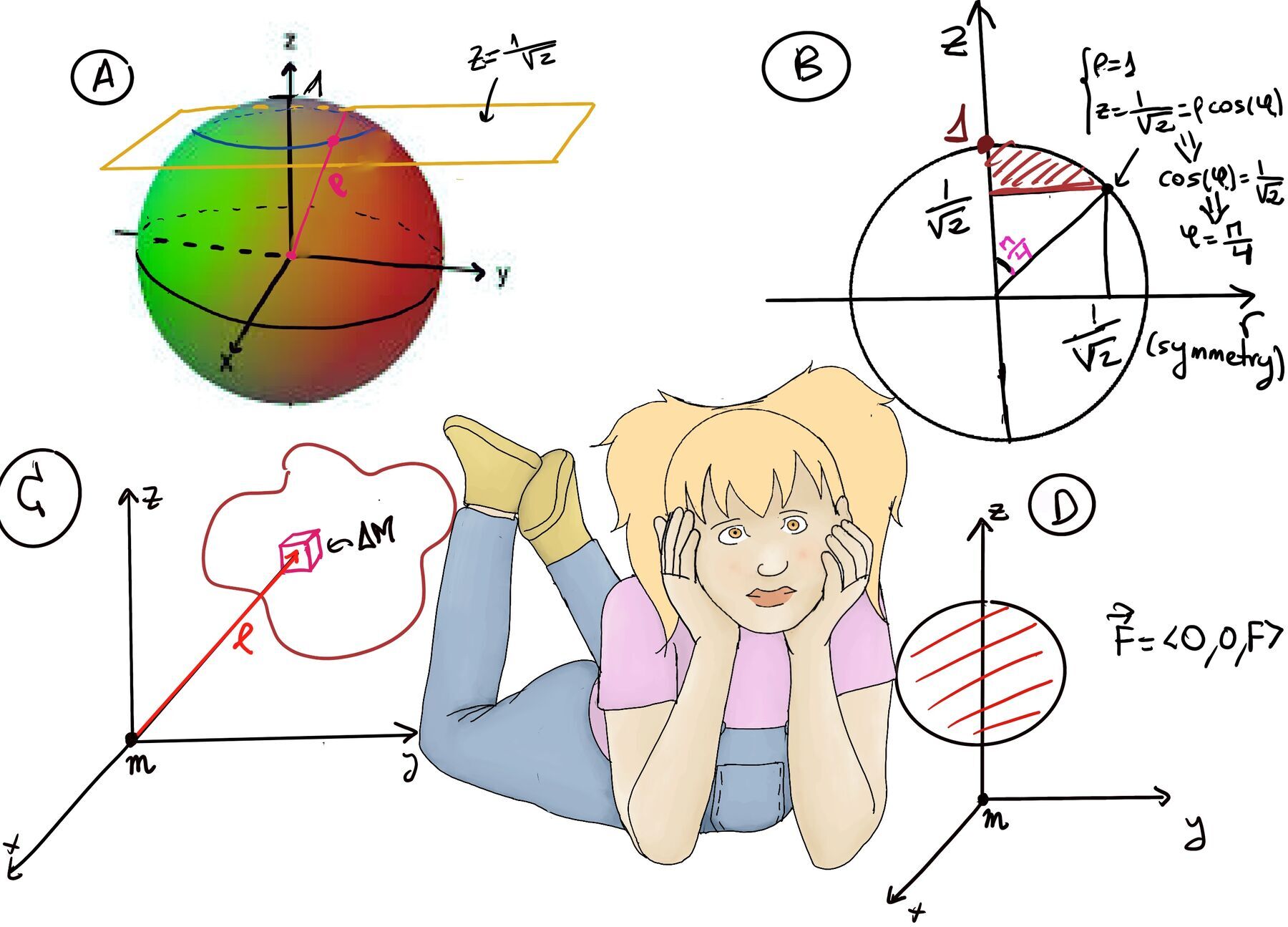
|
 |
 |

|
 |
 |
Life is a math equation. In order to gain the most, you have to know how to convert negatives into positives, Anonymous.
Pure mathematics is, in its way, the poetry of logical ideas, Albert Einstein.
Spherical coordinates are a system for representing points in three-dimensional space (P) using three parameters: radial distance r, polar angle θ, and azimuthal angle ϕ. In other words, it describes or specifies the position of a point in three-dimensional space by three numbers (r, θ, φ) (Figure i)

They make it simple to describe a sphere (ρ = a are spheres of radius a centered at the origin), just as cylindrical coordinates make it easy to describe a cylinder (Figure ii).
Let’s consider the plane of the visual field as being a representation of the xy plane, Figure 3, and we get z = ρcos(φ), r = ρsin(φ) ⇒[Cylindrical conversion formulas, x = rcos(θ), y = rsin(θ), z = z] x = rcos(θ) = ρsin(θ)cos(θ), y = rsin(θ) = ρsin(θ)sin(θ), and z = ρcos(φ).
φ = π⁄4 is a cone (Figure iv), φ = π⁄2 is the xy plane.
We are trying to calculate triple integral, so we need to know dV (Figure v), and we obtain dV = ρ2sin(φ)dρdφdθ.

V = $\int \int \int 1·dV = \int \int \int 1·ρ^2sin(φ)dρdφdθ = $[We leave the sphere when ρ = 1 and enter the region where we enter the plane ↭ $z = \frac{1}{\sqrt{2}}⇒ ρcos(φ) = \frac{1}{\sqrt{2}} ⇒ ρ = \frac{1}{cos(φ)\sqrt{2}} = \frac{sec(φ)}{\sqrt{2}} $ ]$ = \int \int \int_{\frac{sec(φ)}{\sqrt{2}}}^{1} ρ^2sin(φ)dρdφdθ$ = The lower bound for φ is easy as we start at the North Pole when φ = 0, Figure B illustrates the other bound. $\int \int_{0}^{\frac{π}{4}} \int_{\frac{sec(φ)}{\sqrt{2}}}^{1} ρ^2sin(φ)dρdφdθ$ = [As we move all move all around the z axis, θ ∈ [0, 2π]] $\int_{0}^{2π} \int_{0}^{\frac{π}{4}} \int_{\frac{sec(φ)}{\sqrt{2}}}^{1} ρ^2sin(φ)dρdφdθ = \frac{2π}{3}-\frac{5π}{6\sqrt{2}}$
$ \int_{0}^{2\pi} \int_{0}^{\frac{\pi}{4}} \int_{\frac{\sec(\phi)}{\sqrt{2}}}^{1} \rho^2 \sin(\phi) , d\rho , d\phi , d\theta = \int_{0}^{2\pi} \int_{0}^{\frac{\pi}{4}} \left[ \frac{1}{3} \rho^3 \sin(\phi) \right]_{\frac{\sec(\phi)}{\sqrt{2}}}^{1} d\phi d\theta \quad =$
$\int_{0}^{2\pi} \int_{0}^{\frac{\pi}{4}} \left( \frac{1}{3} \sin(\phi) - \frac{1}{3·2·\sqrt{2}} \sec^3(\phi) \sin(\phi) \right) \ d\phi \ d\theta$
$\int_{0}^{2\pi} \left[ -\frac{1}{6\sqrt{2}} \int_{0}^{\frac{\pi}{4}} \sec^3(\phi) \sin(\phi) d\phi + \frac{1}{3} \int_{0}^{\frac{\pi}{4}} \sin(\phi) d\phi \right] d\theta \quad$
$\frac{1}{3} \int_{0}^{\frac{\pi}{4}} \sin(\phi) d\phi = -cos(\phi)\bigg|_{0}^{\frac{\pi}{4}} = -cos(\frac{\pi}{4})+cos(0)=-\frac{\sqrt{2}}{2}+1$
$\int_{0}^{\frac{\pi}{4}} \sec^3(\phi) \sin(\phi) d\phi$ =[… Left to the Reader, but it will be long and painful like a kick to the groin+]a
The gravitational force is a force that attracts any two objects with mass. Newton’s law of universal gravitation states that every particle in the universe attracts every other particle with a force that is directly proportional to the product of their masses and inversely proportional to the square of the distance between their centers.
The equation for universal gravitation thus takes the form, $F = G\frac{m_1m_2}{r^2}$ where F is the gravitational force acting between the two objects (masses), m1 and m2 are the masses of the two objects, r is the distance between the centers of their masses, and G is the gravitational constant.
We want to calculate the gravitational force $\vec{F}$ exerted by an object on a mass m located at the origin. To calculate the gravitational force exerted by a small differential mass ΔM located at coordinates (x, y, z) on a mass m located at the origin we use the formula:
$|\vec{F}| = G\frac{ΔM·m}{ρ^2}, dir(\vec{F}) = \frac{⟨x, y, z⟩}{ρ}$ where $|\vec{F}|$ is the magnitude of the gravitational force, ρ is the distance from the differential mass to the origin, ⟨x, y, z⟩ is the position vector of the differential mass, and the direction of the force is a unit vector. Therefore, $\vec{F} = \frac{G·ΔM·m}{ρ^3}⟨x, y, z⟩$ (Figure C).

To calculate the gravitational force exerted by the entire object, we integrate the gravitational force over the entire volume occupied by the object.
Recall that ΔM = δ· ΔV, where δ is the density, and ΔV is the volume element.
$\vec{F} = \int \int \int \frac{G·m·⟨x, y, z⟩}{ρ^3}δdV$ =[It is complex enough, so it is very useful to simplify by using spherical coordinates and place the solid in a way that the z-axis is an axis of symmetry, so the gravitational force will be directed along the z-axis -Figure D-, that is, $\vec{F}=⟨0, 0, z⟩$] =$\int \int \int \frac{G·m·z}{ρ^3}δdV = \int \int \int \frac{G·m·ρcos(φ)}{ρ^3}δ·ρ^2sin(φ)dρdφdθ = Gm \int \int \int δ·cos(φ)sin(φ)dρdφdθ$